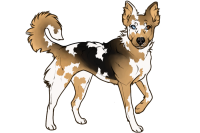

───────────────────────────────────────────────────────
- adopts ✦ breed standards ✦ breeding ✦ imports + myo ✦ pony registry
stable registry ✦ point system ✦ ranks ✦ breed scoring ✦ studbook
showing ✦ merits ✦ store ✦ classifieds ✦ archives ✦
The Cumberland Stock Pony is a relatively old North American breed, with the first crosses originating in the Appalachian Mountains in the years following the Civil War, when Narragansett Pacers and Norfolk Trotters imported to Tennessee were bred with the wild Chincoteague ponies off the barrier island of Assateague in Maryland and Virginia. Originally, these first crosses were only considered a "type" of horse, not a specific breed, and were bred to work as pit ponies in the coal mines of Tennessee, Kentucky, and West Virginia. Sable Island Ponies, praised for their work in the coal mines in Nova Scotia, were later brought over and crossed with these first working horses to improve the breed. It wouldn't be until the turn of the twentieth century that the breed would be brought up from underneath the ground, when they were crossed with Morgan horses and Thoroughbreds, that their use outside of the mines would be noticed. These new crosses were seen as all-purpose horses, used for pulling coaches and as riding horses. They were also used as stock horse by local cattlemen, and were praised for their smooth gaits, stamina, and surefootedness. The Cumberland Pony was also increasingly used for sport, and found success in harness racing.
When World War I broke out, thousands of Cumberland Ponies were shipped to Europe to be used as cavalry mounts by the Allied Forces. Sadly, many of these horses would never return to their homes in the mountains, and the years following Armistice Day saw the numbers of ponies dwindling. In the forties, efforts were made to preserve the breed, using the semi-wild descendants of the few horses who returned to American shores following the war. During this time, the Quarter horse was growing in popularity, with the American Quarter Horse Association having been formed a few years prior. Both Quarter horses and the new Quarter Pony, developed from horses who did not meet the AQHA's original height standard of 14.2hh, were crossed with these descendants, thus creating the modern Cumberland Stock Pony. The Cumberland Stock Pony Society was begun in 1984. In the early days of the society, breeding was, for the most part, unofficially monitored, and included crosses from Appaloosas and Criollos. It wasn't until the early 2000s that the society began to limit its criteria for registration, and many of those crosses were deemed unsuitable. The society does still accept these crosses to be registered, but they must meet the highest standards in order to be considered, and thus, are not common.
Today, the Cumberland Stock Pony sees success in a variety of disciplines, and can be seen competing in both English and Western classes, including but not limited to cutting, western pleasure, working cow horse, dressage, and hunter jumping. Later crosses with Welsh Ponies and North American Sportponies have also found success in show jumping and cross country, those these are not as common. Outside of the show ring, many Cumberland Stock Ponies are used as trail horses and companions, and are praised for their steady natures, willingness, and loyalty. Cumberlands are also used as Pony Club and 4H mounts for youths throughout the country thanks to their quiet temperament and capability to perform a variety of disciplines. Cumberland Stock Ponies have been proven to be easy keepers, with most requiring little to no maintenance. In more recent years, there has been an increase in Cumberland Stock Ponies in therapeutic riding thanks to their calm demeanor. The Cumberland Stock Pony Society has become nationally recognized, and now holds several annual shows and offers incentives for breeders.

























